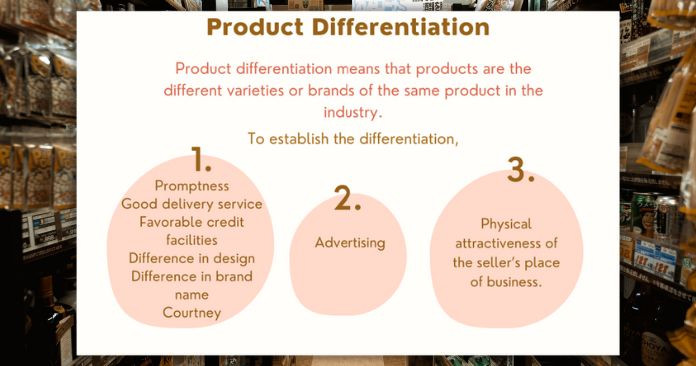Monopolistic competition assumptions will be discussed in this article.
The monopolistic competition market structure can consider as a combination of perfect competition and monopoly market conditions. Also, it is one of the most common market structures in the real world.
In addition, it is a market structure in which a large number of sellers sell differentiated products which are close but not perfect substitutes to one another.
Under monopolistic competition, we can discuss the following topics.
- Monopolistic Competition Assumptions
- Monopolistic Competition Equilibrium
- Demand Curve of a Firm
- Short-run Equilibrium of a Firm
- Long-run Equilibrium of a Firm
- Monopolistic Competition and Economic Efficiency
In this article, you will learn about monopolistic competition assumptions.
Monopolistic Competition Assumptions
When the following requirements are satisfied, a market is considered to be operating under monopolistic competition.
- Large number of sellers and buyers are in the group.
- The products are differentiated, yet they are close substitutes for each other.
- Free entry and exit from the market
- Perfect knowledge or information (all aspects of the ‘product group’)
Let’s discuss these conditions one by one.
1. Large number of sellers and buyers are in the group
In fact, this condition is similar to the condition in perfect competition. This condition implies that one seller provides only a small share of the market demand. One cannot make any influence on the market price by their individual actions.
This condition is different from the corresponding condition in Monopoly. Under the monopoly, there is only one seller in the market. He can make an influence on both price and market supply.
Large number of buyers means that individual buyers cannot make any influence over the market price and output.

2. The products are differentiated, yet they are close substitutes for each other.
The products of the monopolistically competitive firms are not homogeneous. They are differentiated products that are close substitutes for each other. This condition is different from the corresponding condition of perfect competition. The products are homogeneous in perfect competition.
Product differentiation means that products are the different varieties or brands of the same product in the industry.
Each company sells a different variation of the same product that the other firms in the market offer. At the very least, buyers believe that the products are different from one another. Since the products of the firms are varieties of the same product, they are close substitutes for each other.
Examples are toothpastes, soaps, service of hotels and saloons, etc.
What are the strategies to establish the differentiation?
Sellers use a variety of strategies to establish differentiation. One of the key strategies is advertising. Advertisements are used by firms to try to attract customers to their products. Modern society’s most powerful advertising mode is electronic media, which includes television and the internet.
Firms use a variety of other marketing methods in addition to advertising, such as promptness, curtsey, good delivery service, and advantageous credit facilities, as well as differences in design, brand name (for example, the same drug is sold under different brand names), and so on.
Another source of differentiation is attributed to the physical attractiveness of the seller’s place of business.

Aim of the product differentiation
Axiom of minimum differentiation
The goal of product differentiation, whatever of strategy, is to make the product unique in the minds of customers. Differentiation is only effective if consumers treat each firm’s products differently.
Firms do not claim that their product is completely different from the products of other firms when establishing difference. Instead, what they attempt to do is to encourage consumers to accept the product of a particular firm is unique.
This is called ‘the axiom of minimum differentiation’.
As a result of the differential, the producer has considerable flexibility in determining the price of his product. He is not a price-taker (as in perfect competition). Instead, he has some monopoly power that he can use to his advantage. This is the monopoly attribute of this market model.
However, he is up against strong competition from other firms’ close substitutes. As a result, the company’s pricing choice is limited. This market structure is known as monopolistic competition because it contains characteristics of both monopoly and perfect competition.
3. Free entry and exit from the market
Another monopolistic competition assumption is that entry and exit from the market is free
Potential sellers are not limited in their ability to join the market. They can enter the market at any time. Existing firms can also quit the market without limitation if they find it unfavorable.
4. Perfect knowledge or information
Firms under monopolistic competition have a reasonable knowledge of all aspects of the product group. Each company has a strong sense of how much other companies pay for inputs and how much they charge for output. They all have the same level of access to the existing technological base, government licenses, and other market data.
- All characteristics except (ii) (The products are differentiated, yet they are close substitutes for each other) create the condition of perfect competition in the market.
- Product differentiation provides monopoly power to the firm.
Thus, monopolistic competition can describe as a middle ground between two extremes. Perfect competition on the one hand and monopoly on the other hand.
Do you have a question about something I discussed?
I’d appreciate hearing from you in either case. So go ahead and leave your thoughts in the comments section below


